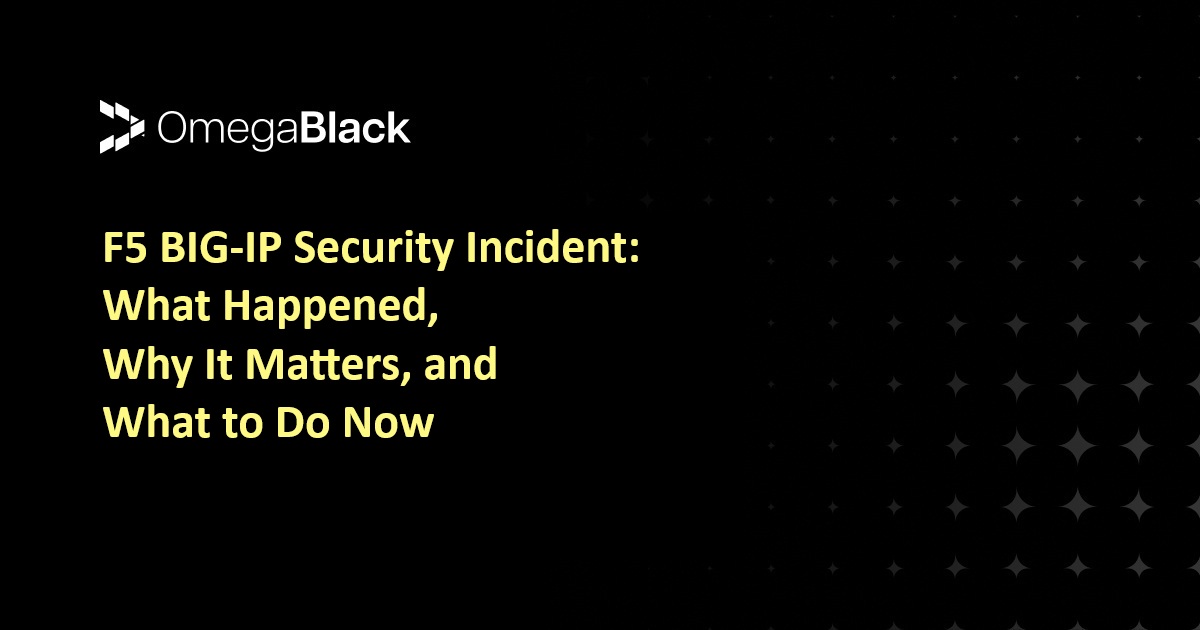F5 BIG-IP Security Incident: What Happened, Why It Matters, and What to Do Now

Overview
In October 2025, F5 Networks disclosed a significant cybersecurity incident involving the compromise of internal systems and exfiltration of sensitive data, including portions of its BIG-IP source code and details on undisclosed vulnerabilities. The company classified the attackers as a “highly sophisticated nation-state threat actor” that maintained long-term access to its development and engineering environments.
While F5 stated that its containment efforts were successful and there was no evidence of exploitation or supply-chain tampering, the exposure of proprietary source code and unpatched vulnerability information poses broad risks across global enterprise and government environments that rely on F5 technology.
The incident prompted the U.S. Cybersecurity and Infrastructure Security Agency (CISA) to issue Emergency Directive 26-01, mandating immediate patching and hardening actions across federal agencies and recommending similar urgency for all F5 customers.
Incident Timeline
- August 9, 2025 — F5 discovered unauthorized access to internal systems.
- September 12, 2025 — The U.S. Department of Justice authorized delayed public disclosure to allow remediation and containment.
- October 15, 2025 — F5 filed its SEC 8-K disclosure, publicly confirmed the breach, and began direct notifications to affected customers.
- October 15, 2025 — CISA issued Emergency Directive 26-01, directing federal agencies to patch and inventory affected devices.
- October 17, 2025 — Global exposure analysis revealed hundreds of thousands of BIG-IP instances visible on the public internet, amplifying urgency for immediate remediation.
Scope of Compromise
Confirmed exfiltrated data:
- Portions of F5 BIG-IP proprietary source code.
- Information on unpatched vulnerabilities under active development.
- Limited configuration and implementation data affecting a small percentage of customers.
Not compromised (per F5’s internal reviews and third-party validation):
- CRM, financial, and customer support systems.
- iHealth diagnostic platform.
- Source code and development environments for NGINX, F5 Distributed Cloud Services, and Silverline.
- Software supply-chain integrity (build and release pipelines validated by NCC Group and IOActive).
Environment and Systems Involved
The breach focused on F5’s product development and engineering knowledge management systems, two environments that form the core of its software design and vulnerability research process. These systems are not customer-facing; they exist deep inside the organization’s R&D and build infrastructure. Their purpose is to store proprietary source code, compile builds for internal validation, and maintain vulnerability tracking data before public patching. Intrusion into such an environment grants a threat actor direct visibility into how F5 engineers test, validate, and fix vulnerabilities, essentially handing over the company’s architectural playbook. This makes the compromise not just a theft of data but an exposure of institutional process intelligence: build pipelines, code review workflows, and internal debugging practices. When a network edge technology provider’s development systems are compromised, the risk transcends the immediate company, it cascades to every entity relying on that software for perimeter defense.
What makes this breach particularly consequential is that the attacker’s persistence inside these environments allowed time to map interdependencies across systems that underpin F5’s broader product ecosystem. Even if there was no confirmed tampering with production code, prolonged access to the development fabric means potential insights into toolchains, dependency libraries, and signing infrastructure. These details can be weaponized later to reproduce exploit conditions or design malicious patches that appear authentic. It underscores the modern reality that software supply chain security does not begin at code compilation but at the very first integration of internal knowledge systems. The F5 incident demonstrates that when an attacker compromises the locus of innovation, the aftershocks ripple across every downstream network that depends on it.
Attribution Status
No confirmed threat group has taken responsibility for the attack.
However, multiple intelligence sources and post-incident analysis indicate strong alignment with China-nexus advanced persistent threat (APT) operations, most notably the clusters tracked as UNC5221 and UNC5291. These groups are associated with long-term cyber-espionage campaigns targeting technology providers, SaaS vendors, and network edge infrastructure.
The malware family BRICKSTORM, previously linked to UNC5221, has been referenced in materials shared with affected F5 customers. BRICKSTORM is a Golang-based backdoor engineered for persistent, stealthy access across Linux and Windows environments, with operational dwell times averaging over a year.
The duration and tradecraft observed—prolonged undetected access, emphasis on network-device environments, and focus on source-code exfiltration—mirror known Chinese APT methodologies aimed at future exploitation and intelligence collection rather than immediate disruption.
Government and Industry Response
CISA Emergency Directive 26-01
CISA’s directive orders all Federal Civilian Executive Branch agencies to:
- Inventory all BIG-IP hardware, virtual, and cloud instances.
- Assess Exposure of management interfaces accessible from the public internet and restrict or remove them immediately.
- Patch Systems by specific deadlines:
- October 22, 2025 for core BIG-IP software families (F5OS, BIG-IP TMOS, BIG-IQ, and BNK/CNF).
- October 31, 2025 for all remaining devices.
- Disconnect and decommission any F5 devices that have reached end-of-support status.
- Report Compliance to CISA by October 29 (summary) and December 3 (detailed inventory).
The UK’s National Cyber Security Centre (NCSC) issued concurrent guidance echoing these recommendations, emphasizing hardening, continuous monitoring, and vulnerability management.
Exposure Landscape
In the days following disclosure, internet-wide scans revealed an alarming number of publicly accessible F5 BIG-IP devices, hundreds of thousands spread across critical industries and government networks. This visibility on the open internet creates a perfect reconnaissance environment for any actor in possession of the stolen source code or vulnerability data. Many of these exposed systems host administrative interfaces that, if improperly segmented, provide direct control over traffic management and authentication flows. The situation magnifies the threat because even a single unpatched or misconfigured BIG-IP instance can serve as a foothold for lateral movement inside an organization’s network. When the perimeter device itself becomes the target, traditional defense-in-depth strategies lose effectiveness, as the attack originates from what is typically considered a trusted internal gateway.
Beyond the sheer number of exposed devices, the geographic and organizational distribution paints a sobering picture of dependency on F5 infrastructure. Financial institutions, telecom providers, energy operators, and public sector agencies all rely on these systems to manage encrypted sessions and application delivery at scale. That makes every unpatched interface a potential national or corporate risk point. The exposure landscape is therefore not simply about patch compliance, it’s about understanding how a single product family underpins critical layers of digital infrastructure worldwide. In this context, the F5 breach becomes less a contained corporate incident and more a stress test for global cyber resilience. The organizations that treat this as a wake-up call and move decisively to reduce their attack surface will be the ones that stay standing when the next major compromise unfolds.
Omega Assessment
The Omega Cyber Threat Analysis Team assesses that this incident represents a critical inflection point for network-edge security and supply-chain assurance.
Technical Impact Assessment:
- Source Code Exposure: Attackers now possess a deep architectural understanding of BIG-IP internals, facilitating static analysis for undiscovered logic flaws and rapid development of targeted zero-day exploits.
- Vulnerability Intelligence Theft: The theft of in-progress vulnerability data shortens the exploit development lifecycle, potentially enabling attackers to weaponize flaws before vendors can publicly patch them.
- Systemic Risk: BIG-IP devices serve as traffic and identity gateways in critical infrastructure; compromise can lead to credential theft, API-key exposure, lateral movement, and persistence within high-value networks.
Containment and Remediation Effectiveness:
F5’s immediate response actions—rotating all credentials and signing keys, enhancing access controls, deploying advanced monitoring tools, and performing independent validation of its code and build pipelines—reflect a mature and well-orchestrated incident response. Engagement with Mandiant, CrowdStrike, NCC Group, and IOActive indicates layered verification and remediation rigor.
Residual Risk:
Despite these measures, the stolen data’s utility persists indefinitely. Threat actors with access to proprietary source and vulnerability intelligence may continue developing exploits for years. Omega assesses the residual exposure risk for global F5 customers as elevated, pending full adoption of mitigations and rapid patch deployment.
Recommended Actions for Organizations
- Enumerate and Audit Assets
- Identify all F5 BIG-IP, F5OS, BIG-IP Next, and BIG-IQ systems across production and lab environments.
- Ensure management interfaces are restricted to trusted, internal networks only.
- Apply All Current F5 Patches
- Validate installation integrity using F5-published checksums.
- Schedule rapid updates for any delayed systems.
- Implement Hardening and Monitoring
- Forward all BIG-IP event logs to centralized SIEM systems.
- Enable remote syslog monitoring and configure anomaly detection for authentication attempts and configuration changes.
- Engage in Threat Hunting
- Use F5’s published threat-hunting guide to detect signs of compromise, with emphasis on indicators associated with BRICKSTORM.
- Retire Legacy Devices
- Immediately disconnect and replace all end-of-support BIG-IP appliances.
- Adopt Continuous Validation
- Establish recurring audits of firmware integrity and configuration baselines.
- Integrate supply-chain security into vendor-risk programs.


